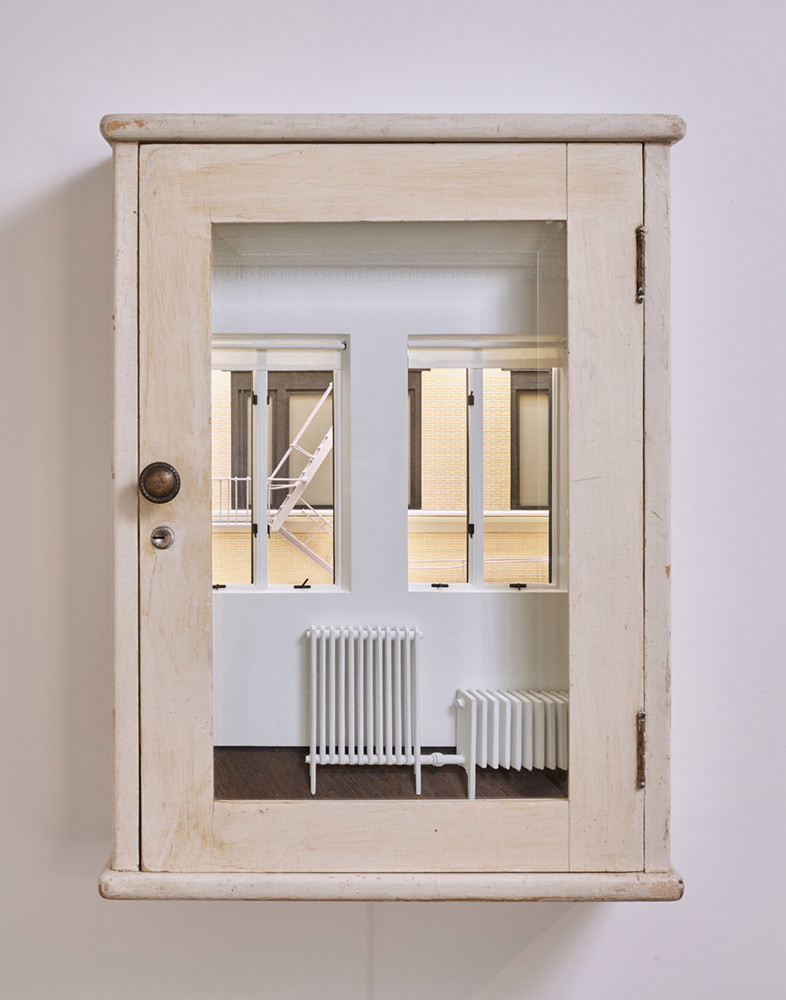[ad_1]
There is an element of surreal playfulness to Meredith James’s work. At first glance, “Shadows on the Wall,” her exhibition at Jack Hanley, looked like a sparse arrangement of nondescript midcentury furnishings: an armchair, desk, office chair, medicine cabinet, hanging light, and rotary phone. Upon inspection, these items revealed a surprise. Embedded in each was a trompe l’oeil sculptural relief depicting a miniature interior—another world contained within the ordinary furnishing.
James’s previous works have often taken the form of immersive sculptures and installations that address perceptual phenomena. First exhibited at Socrates Sculpture Park in 2014, her installation Far from this setting in which I now find myself was an open-air version of an Ames room: a structure that appears to be a cuboid room when viewed through a peephole in its wall, but that actually has differing angles, a tilted floor, and perspectival distortions that together produce the optical illusion that people inside the space are of dramatically different sizes depending on where they stand. James’s installation featured a background painted to resemble a park promenade, exploiting the relationship between the depicted landscape and the surrounding environment to heighten its destabilizing effects.
The most successful sculptures in “Shadows on the Wall” engaged the viewer in similar perceptual games on a smaller scale. In Gallery Reflection (all works 2019), the mirror of a plain wooden medicine cabinet was replaced with a scale model of the gallery wall opposite the sculpture. The work prompted the viewer to glance repeatedly between the actual wall and the sculpture to cross-reference the details: the radiators, bricks, molding, and fire escape were all meticulously reproduced, and an LED light gave the scene the ambience of daylight. While the embedded diorama was a convincing stand-in for a mirror reflecting the sculpture’s surroundings, the viewer’s own reflection was missing, disrupting the perceptual continuity of the encounter.
The sound of running water emanated from Bathroom Sink, a wall-mounted rotary phone with its receiver lying on the floor beneath it. A quarter-size peephole below the dial revealed a minuscule white sink with a tiny working faucet. With the disorienting sound component and the seemingly impossible presence of functional plumbing, the sculpture possessed a sense of delightful absurdity, which was amplified by the extreme contrast in scale between the phone and the sink.
In most of the other works on view, however, the relationships between the furnishings and the sculptural additions were less compelling. In Library, a diorama of a library with rows of identical books was inserted into a cozy armchair where the seat met the back. The illusion felt one-note, the artist relying entirely on the oddity of the inversion—a library inside a chair instead of the other way around—to animate the work. More arbitrary—and gimmicky—was Elevator Doors, a mustard-colored desk chair in which a small mechanized elevator door was embedded. The doors opened at regular intervals, revealing an elevator shaft. Ambiguity can be enriching, but in these works it suggested irresolution. Still, the sheer level of craftsmanship in each of James’s sculptures is commendable, and the miniatures commanded one’s attention even when the conceptual premise fell short.
[ad_2]
Source link


